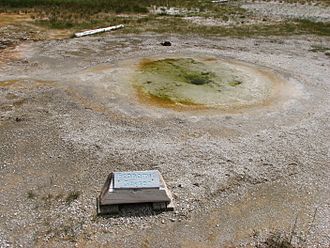Economic Geyser facts for kids
Quick facts for kids Economic Geyser |
|
|---|---|

Economic Geyser's Pool
|
|
| Name origin | Named by Frank Jay Haynes between 1883-1916 |
| Location | Upper Geyser Basin, Yellowstone National Park, Teton County, Wyoming |
| Type | Fountain geyser |
| Eruption height | 10–25 feet (3.0–7.6 m) |
| Frequency | Last erupted in 1996 |
| Duration | Seconds |
| Discharge | small |
The Economic Geyser is a special kind of hot spring found in Yellowstone National Park in the United States. It is located in an area called the Upper Geyser Basin in Teton County, Wyoming. Geysers are natural hot springs that erupt, shooting hot water and steam into the air.
Contents
What is Economic Geyser?
Economic Geyser is a smaller geyser. It is usually quiet and does not erupt often. You can find it between two other famous geyser groups: the Giant Geyser group and the Grand Geyser group.
Why is it Called "Economic"?
This geyser got its unique name because of how it used to behave. When it was very active, most of the water it shot out would drain right back into its opening. This made it look like the geyser was "saving" or "economizing" its water. It is believed that Frank Jay Haynes, a park photographer from 1883 to 1916, gave it this interesting name.
Economic Geyser's History
Economic Geyser was once a very popular geyser. It used to erupt quite often. However, around the 1920s, it became mostly quiet. This means it stopped erupting regularly. Its last known eruption was in 1996.
Clues from the Water: How Geysers Change
The water in geyser pools and other hot springs often has colorful bacteria living in it. The color of these bacteria can tell scientists about the water's temperature. For example, changes in the size and color of the bacteria mats at Economic Geyser suggest that the water might be getting hotter.
Photographs taken in the 1990s show the geyser's pool was quiet and very dark with algae. But pictures from 2006 show a clear pool. This clear water had traces of bacterial colors that are linked to higher temperatures. This suggests the geyser's underground heat might be changing.

